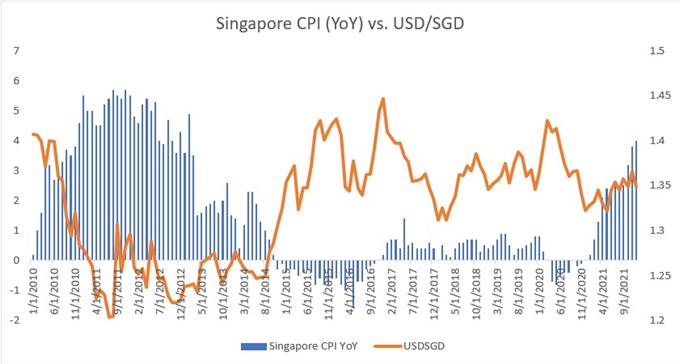STRAITS TIMES INDEX FORECAST: Bullish
- The Straits times index rallied 9.9% year-to-date, outshining regional peers on reflation hopes
- Local banks including DBS and UOB posted stronger-than-expected 4Q earnings, underscoring an economic recovery
- Ukraine risks and the Fed’s hawkish shift in monetary policy may weigh on market sentiment
Singapore’s stock benchmark Straits Times Index (STI) registered a 9.9% gain this year, outperforming global peers. The rally seems to be driven by improving economic conditions, with growth in business activity and consumer spending picking up. That is as the city state gradually exits from the Covid-related restrictions and prepares to open its border to global travellers. Singapore’s GDP grew 7.6% last year, and the economy is projected to expand by 3-5% in 2022.
The STI is a bank-heavy index, with the three local lenders – DBS, OCBC and UOB – accounting for approximately 44% of the index’s weight. The trio have benefited from a post-Covid global recovery and substantial reduction of provisions as asset quality improves, according to the latest financial filings. Net interest income was supported by robust loan expansion, with DBS and UOB reporting 9% and 10% growth in loans in 4Q respectively. Fee income soared on rising demand for wealth management, investment banking and card spending.
Both DBS and UOB’s share prices surged to all-time highs after the release of results. OCBC will announce its earnings this Wednesday. Looking ahead, as the Federal Reserve is preparing to raise interest rates multiple times this year, lenders will further benefit from higher net interest margin, which is a key measurement of a bank’s profitability. Meanwhile, rising inflation in the US may urge the Fed to take a more aggressive approach to tighten monetary policy, weighing on risk assets like stocks. Against this backdrop, Singaporean banks’ ascending trend may be moderated.
Singapore Banks vs. Straits Times Index
Chart Created by TradingView
Looking ahead, key risk events include the Ukraine crisis, rising inflation and uncertainties surrounding the Fed’s first rate hike and subsequent balance sheet reduction. Markets remain highly vigilant about a possible Russian attack on Ukraine as the situation remains fluid and ambiguous, rendering risk assets vulnerable to large price swings. A further escalation in the situation will weigh on risk sentiment and spur flight to safe havens.
Singapore’s CPI hit an eight-year high of 4.0% in December, prompting the Monetary Authority of Singapore (MAS) to adjust monetary policy in between scheduled policy meetings to rein in inflation. The central bank steepened the slope of the S$NEER curve to slightly raise the rate of appreciation of the Singapore Dollar. A stronger SGD may dent the city state’s exports, making them less competitive in the global market. For consumers, the MAS will probably have to take more actions to effectively bring down price levels as the island country is highly reliant on imports.
Singapore CPI vs. USD/SGD

Source: Bloomberg, DailyFX
— Written by Margaret Yang, Strategist for DailyFX.com To contact Margaret, use the Comments section below or @margaretyjy on Twitter


Be the first to comment